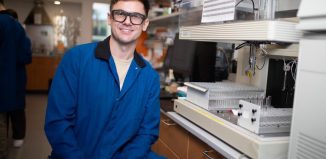Dr. Adrian Krainer: working to cure spinal muscular atrophy
When their son Dylan was under a year old, Debbie and Ron Cuevas noticed he couldn’t support his head and had trouble rolling over. They brought him to a pediatrician, who diagnosed Dylan with spinal muscular atrophy.
The doctor said he likely had two years to live. Determined to make every day count, the Cuevas family of Rockville Centre has rallied around their son, who is now 8 and in third grade.
A genetic disease with varying severity that weakens muscles in the central nervous system, spinal muscular atrophy (or SMA) has no current cure. Some with the disease die because they can’t breathe or swallow. SMA is the leading genetic cause of death among infants and affects about 1 in 6,000 newborns.
Researchers, including Dr. Adrian Krainer at Cold Spring Harbor Laboratory, however, have been working to find a treatment. Krainer has unlocked a potential solution. His work with antisense oligonucleotides (or ASOs) has been impressive enough in the lab and on mice that California-based Isis Pharmaceuticals started using his treatment in the first phase of clinical trials in December. It’s too early to determine the effectiveness of this approach.
SMA is a genetic disorder and is caused by a defective SMN1 gene, which is on the fifth chromosome. That gene produces the survival of motor neuron protein. Without enough of that protein, the motor neurons in the spinal chord gradually die and the muscles they control cease to function.
The solution to this recessive genetic disease may be in the genes themselves. There is a backup gene, called SMN2, that produces the same protein. The problem in children with the disease is that the backup often doesn’t produce enough protein or the protein isn’t complete or breaks apart.
Krainer’s lab has aimed one of its efforts at improving the function of SMN2. The problem with SMN2 is in something called splicing, a process where important pieces of genetic information (exons) are linked together while white noise (introns) is spliced or cut away. The exons are like the proverbial wheat and the introns are the chaff.
As DNA and its cousin RNA go from the genetic blueprint stage to the protein-building stage, there are signposts along the way that indicate whether the next set of genetic instructions is an exon or an intron. A repressor sits on SMN2 at exon 7 that mistakenly sends the cell’s RNA machinery away. The repressor acts like a “Do Not Enter” sign, making it hard for the cell’s machinery to recognize an exon.
Krainer’s lab has created a synthetic molecule called antisense oligonucleotide that replaces that “Do Not Enter” sign and encourages the gene splicing tools to include the information from exon 7 when it builds the survival of motor neuron protein.
In the lab, ASO has done its job, making SMN2 act like its much more effective SMN1 cousin. When Krainer injected ASO into mice with severe SMA, he found that they not only lived longer, but they also were able to grow and develop the same way as mice without the genetic defect.
Krainer’s lab is “changing how the splicing machinery” works, he offered. “We took the repressor out of the picture.”
Krainer has been working on SMA for over a decade. The Uruguay-native who has been at Cold Spring Harbor Lab since 1986 is on the advisory board for two SMA foundations.
He said he quickly moved from understanding SMA as an abstract cell mechanism problem to the urgent need to “do something about it. When [a disease] affects children and very young infants in particular, it is something even more touching.”
Residents of Huntington Station, Krainer and his family have made the Cold Spring Harbor Lab a family affair over the years.
Krainer’s wife Denise Roberts (who met Adrian when they were Ph.D. students at Harvard in the 1980s) is the deputy administrative director of the cancer center at Cold Spring Harbor.
All three of their children — Emily, 22, Andrew, 19 and Brian, 18 — have pitched in at different labs over the years. After she graduates from Brandeis this year, Emily plans to attend medical school and has shown an interest in pediatric neurology. Some day, if her father’s treatment proves effective, Emily may be able to do more for children like Dylan Cuevas than doctors have been able to do up until now.
“I definitely hope [Krainer’s treatment] leads to an improvement,” said Debbie Cuevas, who runs the Families of SMA Greater New York Chapter. “I’m happy to see that it’s going into clinical trials.”
A full-time mom to Dylan and Heather, 5, Debbie Cuevas gave up her job at AIG to take care of her children. Cuevas and her husband, Ron, who works for Chips Technology Group in Syosset, have been through some harrowing times. Dylan has had respiratory failure several times and breathes with the assistance of a respirator.
Still, Cuevas remains positive. “Every day we’re on this Earth is a gift,” she said.
Even if Krainer’s research doesn’t provide the single, definitive solution to SMA, Cuevas believes his research, and that of others, can move science and medicine in the right direction.
Some day, for all the families who pray for a cure, she hopes “someone won’t have to utter the words SMA as a diagnosis.”






